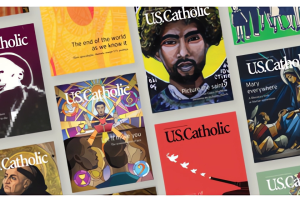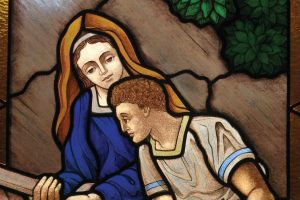c. 2013 Religion News Service
(RNS) From Julie Andrews’ performance as Maria in the 1965 film “The Sound of Music” to Meryl Streep’s portrayal of Sister Aloysius Beauvier in “Doubt” (2008), many Hollywood actresses are particularly conspicuous for their habits. But although habits or veils are thought to symbolize purity – and especially chastity — some films presented a more complicated portrait of nuns.
The title of Maureen Sabine’s new book, “Veiled Desires: Intimate Portrayals of Nuns in Postwar Anglo-American Film” (Fordham University Press), refers to the paradox of having charismatic and photogenic actresses playing chaste nuns and, in the process, drawing attention to the desires their habits were thought to stifle.
Sabine, a professor of literary, cultural and religious studies at the University of Hong Kong, fielded several questions from Religion News Service about her book, which examines portrayals of nuns in more than 60 years of film. The interview was edited for length and clarity.
Q: When and why did you first become interested in this topic?
A: My core research interests in sex and religion, and theology and sexuality, led over time to a correlative interest in women, their gender representation and history.
From a personal point of view, I was influenced by the nuns who taught me: the Dominicans in grade school, and the Ursulines in high school. Both orders have a distinguished history as gifted educators.
I grew up in the era of Betty Friedan’s “Feminine Mystique.” My mother and her friends and neighbors were college-educated but had left the city workforce to raise families in American “House Beautiful” suburbs.
The nuns who taught me were feminist role models, though I did not realize it at the time. They were highly educated — evidently smarter than the parish priests. They instilled an ethic of hard and meaningful work, of social conscience, of a responsibility to develop one’s talents not only for a life of purpose, but in service to others. I admired their strong faith, dedication and care, sense of fulfillment and energy. A rare few were genuinely holy people, and there is nothing more attractive.
Q: Have social media and the digital era made nuns more approachable rather than mysterious?
A: Whether they are nuns in active ministries, visible all over the world, such as the Maryknoll Sisters, or nuns who remain in enclosed, contemplative communities like some Benedictines, nuns are more accessible.
Nuns run websites and blogs that not only give ordinary people insight into their work, but allow them to request the prayers of help, comfort and spiritual strength that lie at the heart of religious life. With professional backgrounds in media and communication arts, nuns have become prominent as film reviewers. They have increasingly become the subject of documentary films.
Q: What kind of impact does it have on an actress to portray a nun?
A: Ingrid Bergman began to feel trapped in the role of religious icon and became intensely irritated when women stopped her to say they hoped their daughters would follow her example as Sister Benedict (in “The Bells of St. Mary’s”) and become a nun.
Today female stars do not have their film persona carefully groomed by the studio system, so Susan Sarandon and Meryl Streep need not fear being saddled with the nun image, though Sarandon came to admire and become close to the real-life Sister Helen Prejean when they worked together on “Dead Man Walking.”
Q: Were there other films that you would have included if you had the time and space? Was there anything you were disappointed that you couldn’t include?
A: My exclusion of the “Sister Act” films has been noted, especially because I discuss another much-loved and entertaining nun film, “The Sound of Music.” I did not include it because I felt it only reinforced nun stereotypes and reinstated the binary of the saint and the whore. I wanted to look at films that were influential and appealing to a general audience, but that opened the door to serious observations about nuns, their lives and vows.













